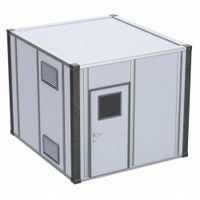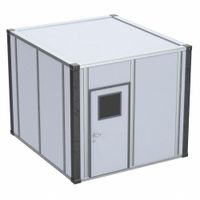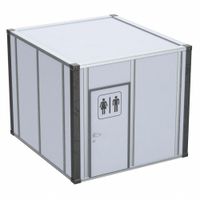Call +(254) 703 030 000 / 751 483 999 / 721 704 777
- Home
- Material Handling
- Storage Workspace
- Buildings Shelters
- Modular Indoor Buildings
.....Read More
Frequently Asked Questions
What are modular indoor buildings?
Modular indoor buildings are prefabricated structures designed for indoor use, constructed using a series of pre-manufactured modules or sections. These modules are built in a factory setting and then transported to the site where they are assembled into a complete structure. This method allows for efficient construction, reduced waste, and minimized disruption to the surrounding environment.
The modular approach offers flexibility in design, allowing for customization to meet specific needs. These buildings can serve various purposes, such as offices, classrooms, laboratories, or retail spaces. The modules are typically constructed using durable materials like steel, wood, or concrete, ensuring longevity and stability.
One of the key advantages of modular indoor buildings is their speed of construction. Since the modules are built off-site, site preparation and module construction can occur simultaneously, significantly reducing the overall project timeline. This is particularly beneficial in environments where time constraints are critical.
Additionally, modular buildings are often more cost-effective than traditional construction methods. The controlled factory environment allows for precise construction, reducing material waste and labor costs. The modular nature also means that buildings can be easily expanded, reconfigured, or relocated, providing long-term adaptability.
Sustainability is another benefit, as modular construction often incorporates eco-friendly materials and energy-efficient designs. The reduced construction time and waste contribute to a smaller carbon footprint compared to conventional building methods.
Overall, modular indoor buildings offer a versatile, efficient, and sustainable solution for a wide range of indoor space needs, making them an increasingly popular choice in various industries.
How do modular indoor buildings benefit warehouses and manufacturing plants?
Modular indoor buildings offer several benefits to warehouses and manufacturing plants:
1. **Flexibility and Scalability**: Modular structures can be easily reconfigured, expanded, or relocated to accommodate changing operational needs. This adaptability allows businesses to scale operations without significant downtime or cost.
2. **Cost-Effectiveness**: Modular construction often requires less time and labor compared to traditional building methods, leading to reduced construction costs. The prefabrication process also minimizes material waste, further lowering expenses.
3. **Time Efficiency**: Since modular components are prefabricated off-site, the on-site assembly is quicker, reducing disruption to ongoing operations. This speed is crucial for businesses needing rapid expansion or reconfiguration.
4. **Minimal Disruption**: The off-site construction of modules means less noise, dust, and interference with daily operations, which is particularly beneficial in environments where maintaining workflow is critical.
5. **Quality Control**: Modular buildings are constructed in controlled factory settings, ensuring consistent quality and adherence to building standards. This controlled environment reduces the risk of defects and enhances the durability of the structures.
6. **Sustainability**: Modular construction is often more environmentally friendly due to efficient use of materials and reduced waste. Additionally, the ability to repurpose and relocate modules supports sustainable practices.
7. **Customization**: Modular buildings can be tailored to specific needs, including specialized storage, office spaces, or production areas, ensuring that the facility meets the precise requirements of the business.
8. **Improved Safety**: The controlled environment of modular construction reduces on-site hazards, enhancing worker safety. Additionally, the quick assembly process minimizes the time workers spend in potentially dangerous construction zones.
9. **Enhanced Space Utilization**: Modular buildings can be designed to optimize space usage, allowing for better organization and workflow within the facility, which can lead to increased productivity.
Can modular indoor buildings be reconfigured or moved?
Yes, modular indoor buildings can be reconfigured or moved. These structures are designed with flexibility and adaptability in mind, allowing for easy reconfiguration to meet changing needs. The modular components, such as walls, floors, and ceilings, are prefabricated and assembled on-site, making it straightforward to disassemble and reassemble them in different configurations. This adaptability is particularly beneficial in environments like offices, schools, and healthcare facilities, where space requirements can frequently change.
The modular design also facilitates relocation. Since the components are prefabricated, they can be transported to a new location and reassembled with minimal effort. This is advantageous for businesses or organizations that anticipate moving or expanding, as it reduces the time and cost associated with traditional construction methods.
Moreover, the modular approach supports sustainable practices. The ability to reuse and reconfigure components minimizes waste and reduces the demand for new materials. This not only lowers environmental impact but also offers cost savings over time.
In summary, the inherent flexibility of modular indoor buildings allows them to be easily reconfigured or moved, providing a versatile and sustainable solution for dynamic space requirements.
What types of spaces can be created with modular indoor buildings?
Modular indoor buildings offer versatile solutions for creating a variety of spaces due to their flexible and customizable nature. Here are some types of spaces that can be created:
1. **Office Spaces**: Modular buildings can be configured into open-plan offices, private offices, meeting rooms, and coworking spaces. They allow for easy reconfiguration to adapt to changing business needs.
2. **Retail Spaces**: Pop-up shops, showrooms, and kiosks can be quickly set up using modular units. These spaces can be customized to reflect brand identity and can be relocated as needed.
3. **Educational Facilities**: Classrooms, laboratories, libraries, and administrative offices can be constructed using modular systems. They provide a quick solution for expanding educational institutions.
4. **Healthcare Facilities**: Clinics, diagnostic centers, and temporary hospitals can be established with modular buildings. They are ideal for rapid deployment in emergencies or for expanding existing facilities.
5. **Residential Units**: Modular buildings can be used to create apartments, dormitories, and temporary housing. They offer a cost-effective and efficient solution for housing needs.
6. **Hospitality Spaces**: Hotels, hostels, and guest houses can be constructed using modular techniques. They allow for scalable and customizable accommodation options.
7. **Event Spaces**: Exhibition halls, conference centers, and banquet halls can be created with modular structures. They offer flexibility in design and can be tailored to specific event requirements.
8. **Industrial Spaces**: Warehouses, manufacturing units, and workshops can be set up using modular buildings. They provide a quick and efficient solution for industrial expansion.
9. **Recreational Facilities**: Gyms, sports centers, and community centers can be developed using modular systems. They offer adaptable spaces for various recreational activities.
10. **Emergency Shelters**: Modular buildings can be rapidly deployed as shelters in disaster-stricken areas, providing immediate relief and accommodation.
These spaces benefit from the speed of construction, cost-effectiveness, and sustainability that modular buildings offer.
How do modular indoor buildings compare to traditional construction?
Modular indoor buildings and traditional construction differ in several key aspects:
1. **Construction Time**: Modular buildings are typically faster to construct. Modules are prefabricated in a factory setting, allowing site preparation and building construction to occur simultaneously. This parallel process can reduce construction time by up to 50% compared to traditional methods.
2. **Cost Efficiency**: Modular construction can be more cost-effective due to reduced labor costs and minimized construction time. The controlled factory environment also reduces waste and material costs. However, transportation and assembly costs can offset some savings.
3. **Quality Control**: The factory setting of modular construction allows for consistent quality control and precision. Traditional construction is more susceptible to weather-related delays and variability in craftsmanship.
4. **Flexibility and Design**: Modular buildings offer flexibility in design and can be easily expanded or reconfigured. However, they may have limitations in customization compared to traditional construction, which can be tailored to specific architectural designs.
5. **Sustainability**: Modular construction is often more sustainable, producing less waste and using energy-efficient processes. The ability to disassemble and relocate modules also contributes to sustainability.
6. **Durability and Longevity**: Both methods can produce durable structures, but traditional construction has a longer track record. Modular buildings are designed to meet the same building codes and standards as traditional buildings.
7. **Site Impact**: Modular construction reduces on-site disruption, noise, and pollution, as much of the work is done off-site. Traditional construction can have a more significant impact on the surrounding environment during the building process.
8. **Financing and Appraisal**: Traditional buildings are more straightforward to finance and appraise, as they are well-understood by lenders and appraisers. Modular buildings may face challenges in these areas due to perceived risks and market unfamiliarity.
What accessories are available for modular indoor buildings?
Accessories for modular indoor buildings include:
1. **Partition Walls**: Movable or fixed walls to create separate spaces within the building.
2. **Doors**: Various types such as sliding, hinged, or bi-fold doors for entry and exit.
3. **Windows**: Fixed or operable windows for natural light and ventilation.
4. **Lighting**: LED, fluorescent, or smart lighting systems for illumination.
5. **HVAC Systems**: Heating, ventilation, and air conditioning units for climate control.
6. **Flooring Options**: Carpeting, vinyl, laminate, or hardwood for different aesthetic and functional needs.
7. **Ceiling Systems**: Acoustic tiles, drop ceilings, or exposed ceilings for sound control and aesthetics.
8. **Electrical Outlets and Wiring**: For powering devices and equipment.
9. **Plumbing Fixtures**: Sinks, toilets, and other plumbing needs for restrooms or kitchens.
10. **Furniture**: Modular desks, chairs, and storage units for office or residential use.
11. **Shelving and Storage**: Built-in or standalone units for organization.
12. **Security Systems**: Cameras, alarms, and access control systems for safety.
13. **Soundproofing Materials**: Panels and insulation to reduce noise.
14. **Decorative Elements**: Wall art, plants, and other decor for aesthetic enhancement.
15. **Technology Integration**: Smart home or office systems for automation and control.
16. **Signage**: Custom signs for navigation and branding.
17. **Fire Safety Equipment**: Smoke detectors, sprinklers, and extinguishers.
18. **Networking Infrastructure**: Cabling and routers for internet connectivity.
19. **Window Treatments**: Blinds, shades, or curtains for privacy and light control.
20. **Exterior Cladding**: Panels or siding for external appearance and protection.
These accessories enhance functionality, comfort, and aesthetics, allowing customization to meet specific needs.
Are modular indoor buildings suitable for cleanrooms and controlled environments?
Yes, modular indoor buildings are suitable for cleanrooms and controlled environments. They offer several advantages that make them ideal for such applications:
1. **Flexibility and Scalability**: Modular buildings can be easily reconfigured, expanded, or relocated, allowing for adaptability to changing requirements or technological advancements in cleanroom standards.
2. **Speed of Construction**: Modular construction significantly reduces build time compared to traditional methods. This is crucial for industries that need to quickly respond to market demands or regulatory changes.
3. **Cost-Effectiveness**: The efficiency of modular construction often results in lower costs. Prefabrication in a controlled environment reduces waste and labor costs, making it a cost-effective solution for cleanrooms.
4. **Quality Control**: Modular components are manufactured in a controlled factory setting, ensuring high-quality standards and precision. This is essential for maintaining the stringent environmental controls required in cleanrooms.
5. **Compliance and Standards**: Modular cleanrooms can be designed to meet specific industry standards and regulations, such as ISO classifications, GMP, or FDA requirements, ensuring compliance with necessary guidelines.
6. **Environmental Control**: Modular systems can be equipped with advanced HVAC systems, filtration, and other technologies to maintain the required temperature, humidity, and particulate levels, essential for controlled environments.
7. **Sustainability**: Modular construction often uses sustainable materials and practices, reducing the environmental impact. This aligns with the growing emphasis on sustainability in many industries.
8. **Reduced Disruption**: Since much of the construction occurs off-site, there is minimal disruption to existing operations, which is beneficial for facilities that need to remain operational during upgrades or expansions.
Overall, modular indoor buildings provide a versatile, efficient, and reliable solution for creating cleanrooms and controlled environments, meeting the specific needs of various industries such as pharmaceuticals, biotechnology, and electronics.



